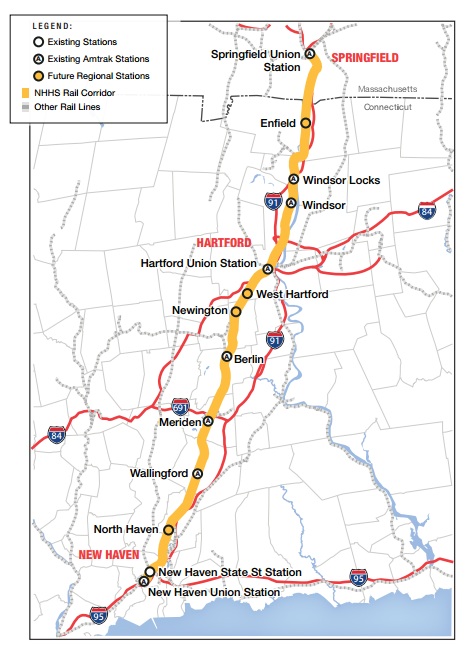
While it is well known that Connecticut does not fare particularly well under MAP-21, the federal transportation law adopted last year, the state appears well-positioned to take advantage of a new provision allowing the use of federal highway funds for transit systems like Metro-North and the New Haven-Hartford-Springfield line.
As Transportation for America points out in its report Making the Most of MAP-21, MAP-21 allows states to use money from the National Highway Performance Program (NHPP), the largest program in MAP-21, to improve transit along Interstate and other major highway corridors, so long as a transit improvement is a more cost-effective way to reduce delays and improve traffic flow than a road project would be. Some federal “highway” programs can already be used to fund transit, such as the Surface Transportation Program and Congestion Mitigation and Air Quality Program. What’s new in MAP-21 is a provision in NHPP, which pays for projects on the National Highway System (NHS), like Interstate highways and some other major roads.
Many of Connecticut’s existing and future transit lines are prime candidates to take advantage of this newfound flexibility: Metro-North Rail parallels I-95 between the New York border and New Haven. Shore Line East runs along I-95 between New Haven and New London. The planned New Haven-Hartford-Springfield commuter rail service will run in the I-91 corridor, while the CTfastrak bus rapid transit system parallels I-84 in stretches–and some have proposed extending the system along the carpool lanes on I-84 and I-91. It’s not a stretch to think that improving these systems would do more to cut congestion than comparable road projects. For example, in the recent past ConnDOT has proposed widening Interstate 95 in southeastern Connecticut where it runs parallel to Connecticut’s Shoreline East rail system. Showing that greater investment in Shoreline East would reduce delays in a more cost-effective way than the widening project would make NHPP funding available for transit investment.
The provision’s exact requirements are described on the Federal Highway Administration’s website, but in short, the agency writes that eligible uses of NHPP funds for transit include:
Construction of a transit project … if the project is in the same corridor and in proximity to a fully access-controlled [i.e. a road without traffic signals, intersections, or driveways] NHS route, if the improvement is more cost-effective (as determined by a benefit-cost analysis) than an NHS improvement, and will reduce delays or produce travel time savings on the NHS route and improve regional traffic flow.
Transportation for America notes that “these are significant hurdles to clear, but given that this is the largest formula program, it is worth considering as an option where possible.” Indeed, this could be a robust source of funds for transit. Under MAP-21, Connecticut will receive about $145 million in federal funds annually for transit (not including one-time competitive grants, like those the state has won for CTfastrak). But the state will receive $274.4 million — nearly double the transit amount — from the NHPP program alone.
NHPP is a key source of road and bridge repair funding, so there are limits on how much funding the state can realistically use for transit improvements. But with plenty of transit needs, like the unfunded second phase of the New Haven-Hartford-Springfield Rail Line, Connecticut could use this new flexibility in federal law to chart a more sustainable path forward.

[…] Connecticut Well-Positioned to Use Fed Funds for Transit (MTR) […]
[…] Blog reports that the city’s efforts to encourage family cycling are paying off. And the Tri-State Transportation Campaign says that a provision of the new transportation bill, MAP-21, could open up a new stream of transit […]
[…] Luckily, federal transportation dollars are incredibly flexible and can be used for a variety of purposes. The question is, will Connecticut stick with an expensive plan to widen a small section of highway […]
[…] in Connecticut. Luckily, federal travel dollars are incredibly flexible and can be used for a variety of purposes. The doubt is, will Connecticut hang with an costly devise to dilate a tiny territory of highway […]
[…] more reliable passenger service,” but its benefits don’t stop there. It will also help decongest highways around Greater Hartford, where more than 80 percent of commuters currently drive alone. The rail […]